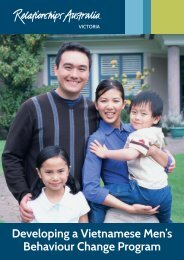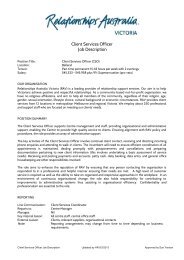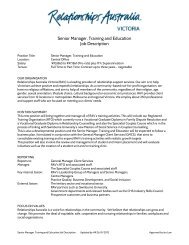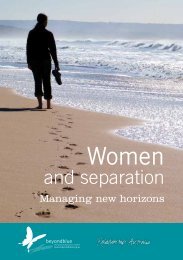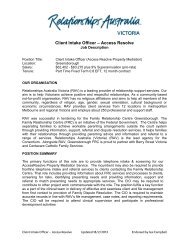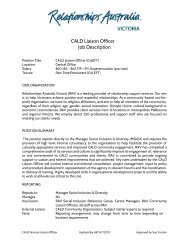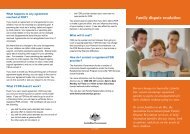Engaging fathers in child and family services - Australian Institute of ...
Engaging fathers in child and family services - Australian Institute of ...
Engaging fathers in child and family services - Australian Institute of ...
- No tags were found...
Create successful ePaper yourself
Turn your PDF publications into a flip-book with our unique Google optimized e-Paper software.
Practice considerationsPractice considerations are general pr<strong>in</strong>ciples based upon lessons from research <strong>and</strong> practicedesigned to provide additional guidance to service providers about specific issues relat<strong>in</strong>g towork<strong>in</strong>g with <strong>fathers</strong>.What methods can <strong>child</strong> <strong>and</strong> <strong>family</strong> <strong>services</strong> use to engage <strong>fathers</strong>?Many <strong>of</strong> the methods for engag<strong>in</strong>g <strong>fathers</strong> are the same as engag<strong>in</strong>g other potentially “hard toreach” groups <strong>in</strong> the community. See How to Engage Disadvantaged Families <strong>in</strong> Child <strong>and</strong>Family Services (McDonald, 2010) for more tips. This Practice Sheet focuses on what methodsappear to be specific to engag<strong>in</strong>g men <strong>in</strong> <strong>child</strong> <strong>and</strong> <strong>family</strong> <strong>services</strong>.Acknowledge men <strong>and</strong> their needs <strong>and</strong> preferencesRecruitment• Most communities have spaces where men gather (e.g., sport<strong>in</strong>g venues <strong>and</strong> events, specificworkplaces). These spaces provide opportunities for promot<strong>in</strong>g programs <strong>and</strong> recruit<strong>in</strong>g <strong>fathers</strong>.• Promot<strong>in</strong>g programs <strong>in</strong> spaces traditionally frequented by men will not necessarily reach allmen <strong>in</strong> a community. For example, men from specific cultural groups may be more likely toattend a local religious <strong>in</strong>stitution than a sport<strong>in</strong>g event.• Fathers may be attend<strong>in</strong>g non-<strong>child</strong> <strong>and</strong> <strong>family</strong> <strong>services</strong> that provide opportunities forpromot<strong>in</strong>g programs (e.g., Centrel<strong>in</strong>k, community-based welfare agencies). Workers at those<strong>services</strong> may not be aware <strong>of</strong> local programs available for <strong>fathers</strong>.• Men may be uncomfortable with programs that emphasise the provision <strong>of</strong> “support” becauseit suggests they are not cop<strong>in</strong>g.• Men are more likely to attend a <strong>child</strong> <strong>and</strong> <strong>family</strong> service if they are encouraged to do so bytheir partners. Similarly, a partner who discourages his <strong>in</strong>volvement may reduce a man’swill<strong>in</strong>gness to engage with a service.For further discussion on acknowledg<strong>in</strong>g men’s needs <strong>and</strong> preferences <strong>in</strong> service delivery, see: O’Brien <strong>and</strong>Rich (2002, pp. 26–32), Berlyn et al. (2008, pp. 24–28); Fletcher, (2004, 67–84), Lloyd et al. (2003), <strong>and</strong> NSWDepartment <strong>of</strong> Community Services (2009).Service delivery• Services that operate only dur<strong>in</strong>g bus<strong>in</strong>ess hours are most accessible to people who are homedur<strong>in</strong>g the day; the majority <strong>of</strong> those people will be parents <strong>and</strong> most <strong>of</strong>ten women.• Flexible hours <strong>of</strong> operation have a significant effect on how accessible a program is to <strong>fathers</strong>.• Positive images <strong>of</strong> men <strong>and</strong> <strong>fathers</strong> <strong>in</strong> a program sett<strong>in</strong>g <strong>and</strong> <strong>in</strong> promotional materials (suchas brochures) shows a service welcomes <strong>fathers</strong> <strong>and</strong> recognises their importance.• Research suggests that many men have a positive response to activities that provide “h<strong>and</strong>son”learn<strong>in</strong>g opportunities through activities such as cook<strong>in</strong>g <strong>and</strong> physical activity (ratherthan sem<strong>in</strong>ars <strong>and</strong> presentations).• Because <strong>child</strong> <strong>and</strong> <strong>family</strong> <strong>services</strong> are <strong>of</strong>ten staffed <strong>and</strong> attended ma<strong>in</strong>ly by women, hav<strong>in</strong>ga male staff member or male volunteers (especially “front <strong>of</strong> house”) may make men feelmore comfortable.• A program specifically for men (e.g., a “Dads” group) may make men more likely to attenda service.CAFCA Practice Sheet | 3




